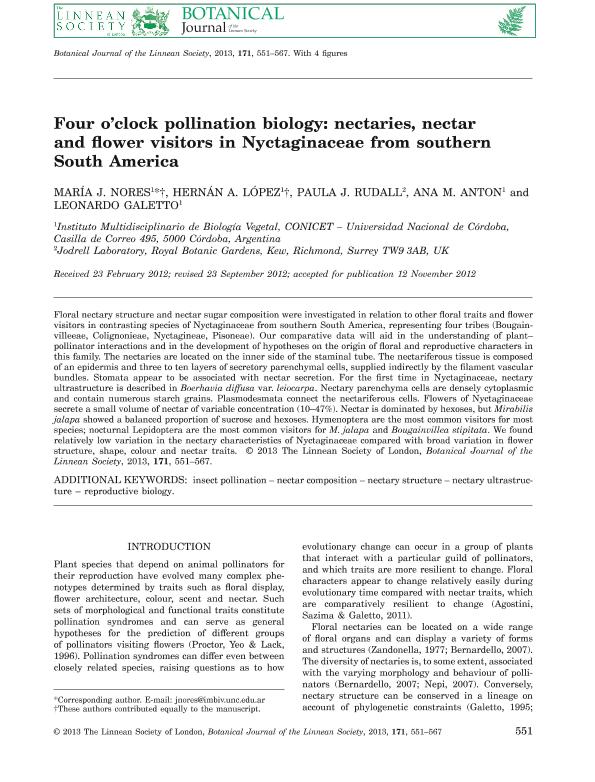Artículo
Four o´clock pollination biology: nectarines, nectar and flower visitors in Nyctaginaceae from southern South America
Fecha de publicación:
10/2013
Editorial:
Wiley
Revista:
Botanical Journal Of The Linnean Society
ISSN:
0024-4074
e-ISSN:
1095-8339
Idioma:
Inglés
Tipo de recurso:
Artículo publicado
Clasificación temática:
Resumen
Floral nectary structure and nectar sugar composition were investigated in relation to other floral traits and flower visitors in contrasting species of Nyctaginaceae from southern South America, representing four tribes (Bougainvilleeae, Colignonieae, Nyctagineae, Pisoneae). Our comparative data will aid in the understanding of plant–pollinator interactions and in the development of hypotheses on the origin of floral and reproductive characters in this family. The nectaries are located on the inner side of the staminal tube. The nectariferous tissue is composed of an epidermis and three to ten layers of secretory parenchymal cells, supplied indirectly by the filament vascular bundles. Stomata appear to be associated with nectar secretion. For the first time in Nyctaginaceae, nectary ultrastructure is described in Boerhavia diffusa var. leiocarpa. Nectary parenchyma cells are densely cytoplasmic and contain numerous starch grains. Plasmodesmata connect the nectariferous cells. Flowers of Nyctaginaceae secrete a small volume of nectar of variable concentration (10–47%). Nectar is dominated by hexoses, but Mirabilis jalapa showed a balanced proportion of sucrose and hexoses. Hymenoptera are the most common visitors for most species; nocturnal Lepidoptera are the most common visitors for M. jalapa and Bougainvillea stipitata. We found relatively low variation in the nectary characteristics of Nyctaginaceae compared with broad variation in flower structure, shape, colour and nectar traits.
Palabras clave:
Pollination Biology
,
Nectar
,
Pollinators
,
Nyctaginaceae
Archivos asociados
Licencia
Identificadores
Colecciones
Articulos(IMBIV)
Articulos de INST.MULTIDISCIPL.DE BIOLOGIA VEGETAL (P)
Articulos de INST.MULTIDISCIPL.DE BIOLOGIA VEGETAL (P)
Articulos(SEDE CENTRAL)
Articulos de SEDE CENTRAL
Articulos de SEDE CENTRAL
Citación
Nores, María Jimena; Lopez, Hernán; Rudall, Paula; Anton, Ana Maria Ramona; Galetto, Leonardo; Four o´clock pollination biology: nectarines, nectar and flower visitors in Nyctaginaceae from southern South America; Wiley; Botanical Journal Of The Linnean Society; 171; 3; 10-2013; 551-567
Compartir
Altmétricas




